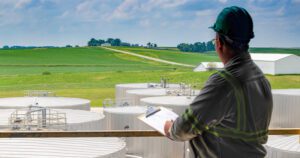By Jonathan Martin, Director of Economics and Market Analytics at Clean Fuels Alliance America
Published in Biodiesel Magazine | Summer Issue
Tremendous growth in the biomass-based diesel industry should be celebrated by producers and farmers, as well as those who enjoy breathing cleaner air and lower greenhouse gas emissions. However, that growth coupled with disappointing Renewable Fuel Standard volumes set by the U.S. Environmental Protection Agency have put stress on the industry. Despite the current storm created by these conditions, new markets rapidly coming online provide a sunnier outlook for the years ahead.
In 2023, biomass-based diesel (BBD) consumption reached just under 4.6 billion gallons. Out of total diesel fuel consumed in the United States in 2023, BBD accounted for around 8%, a significant growth from recent years (approx. 5.5% in 2022). The U.S. Energy Information Agency’s most recent data, which is current through February, shows biodiesel production capacity has remained relatively steady at 2.1 billion gallons per year (BGY), while renewable diesel capacity has expanded up to 3.9 BGY (from 2.2 BGY as recent as October 2022). The main driver for this growth continues to be states with a Low Carbon Fuel Standard. California’s market remains strong, with consumption making up approximately 60% of its entire diesel pool.
Looking forward, renewable diesel capacity expansions and greenfield projects are continuing well into 2024 and parts of 2025. Currently, around 1.65 BGY of renewable diesel production capacity is expected by the end of 2025 in the U.S., with an additional 300 million gallons per year (MMgy) sanctioned in Canada. Sustainable aviation fuel (SAF) projects also continue apace, with an approximate 600 MMgy of production capacity expected by the end of 2025, with the majority of near-term growth coming from the familiar hydroprocessed esters and fatty acids (HEFA) production pathway.
This unprecedented growth eclipsed what the EPA forecasted, greatly exceeding the set rule for 2023. When the set rule was released in June 2023, it was readily apparent that BBD would easily outpace the D4 volume.
LCFS credit prices across the West Coast are also down from recent highs. Recently, there has been huge growth in credit generation, led by BBD, renewable natural gas and electrical vehicle adoption. Looking at the California LCFS, there is currently over 23 million metric tons of LCFS credits in the California credit bank. This is significantly pulling LCFS credit prices down. This is not only occurring in California but in all LCFS states, just not to the same degree.
Although these lower credit prices are concerning for producers, there is reason for hope with growing demand. New markets have been developing in recent years, due to many corporate initiatives to reduce greenhouse gas emissions and lower their collective carbon footprint. Both the rail and maritime industries are primed and ready to begin their transition to lower-carbon fuel sources. Both biodiesel and renewable diesel fit perfectly into their corporate structures, as they can be used as drop-in fuels.
An estimated 80% of the world’s goods are transported by sea, making low-carbon fuel critical for corporations that have made aggressive carbon reduction commitments. Biodiesel sales in marine markets are growing rapidly throughout the world, with B24 blends being sold in high quantities in Singapore and high quantities of B30 blends being sold in northwest Europe.
These companies would like to increase their uptake in biodiesel and renewable diesel blends in the U.S., a 7-billion-gallon market, but there are some hurdles—namely, the inability for ocean-going vessels to get the benefits of renewable identification numbers (RINs). Reps. Mariannette Miller-Meeks, R-Iowa, and John Garamendi, D-California, have introduced legislation aiming to increase the use of renewable biofuels used by sea vessels. By designating renewable fuel used in ocean-going vessels as an “additional renewable fuel” under the RFS, the Renewable Fuel for Ocean-Going Vessels Act would enable companies to preserve RINs in the program. U.S. Sens. Pete Ricketts, R-Nebraska, and Sherrod Brown, D-Ohio, introduced a similar version of the bill in the Senate, and thus far, the bill has shown signs of bipartisan support.
Railroads are another difficult-to-decarbonize sector with dreams of a cleaner future. The rail market is 4 billion gallons in the U.S., and we project that more than 20% will be BBD before the end of the decade. Multiple Class I railroad companies have been setting lofty goals for biodiesel use in their engines as early as 2030. Union Pacific, BNSF and Canadian National, along with other Class I railroads, are already making strides, successfully testing up to 100% BBD.
While there are near-term headwinds for our industry as discussed above, long-term tailwinds are right around the corner. Demand for BBD fuel is going to continue to grow as existing markets expand, and the benefits of these fuels continue to reach new markets.
ABOUT CLEAN FUELS ALLIANCE AMERICA
Made from an increasingly diverse mix of resources such as recycled cooking oil, soybean oil, and animal fats, the clean fuels industry is a proven, integral part of America’s clean energy future. Clean Fuels Alliance America is the U.S. trade association representing the entire biodiesel, renewable diesel and sustainable aviation fuel supply chain, including producers, feedstock suppliers and fuel distributors. Clean Fuels receives funding from a broad mix of private companies and associations, including the United Soybean Board and state checkoff organizations.




